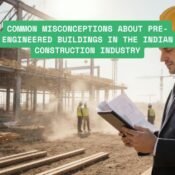19Dec

Key Differences Between Commercial and Industrial Pre-Engineered Steel Buildings
Introduction to Pre-Engineered Steel Buildings for Commercial and Industrial Applications.
Pre-engineered steel buildings have become a popular choice for various construction projects across India, including both commercial and industrial sectors. These buildings are constructed using standardized components that are designed, fabricated, and assembled in a controlled environment before being transported to the site for installation. This method of construction offers several advantages, such as reduced costs, faster build times, customization, and adherence to local building codes and regulations. Commercial pre-engineered steel buildings are typically used for retail stores, office spaces, restaurants, and similar establishments, where customer interaction and aesthetic appeal are key considerations. In contrast, industrial Pre-engineered steel buildings are utilized in manufacturing, warehousing, and other industrial operations where durability, flexibility, and efficient space utilization are essential to accommodate heavy machinery and equipment.Pre-engineered steel buildings are revolutionizing the construction landscape in India with their unparalleled versatility, speed, and cost efficiency.
- Design and Layout Considerations
- Structural Requirements
- Building Height and Clear Span: Industrial buildings often feature higher ceilings and larger clear spans than commercial buildings to allow for tall machinery, overhead cranes, and storage systems.
- Loading and Unloading Areas: Industrial facilities, such as warehouses and distribution centers, require expansive loading docks for efficient goods movement, whereas commercial buildings typically have smaller loading areas, mainly for deliveries or stocking.
- Interior Features and Systems
- Exterior Design and Functionality
- Compliance with Zoning and Permitting Regulations
Tags:commercial steel buildingscost-effective steel buildingscustomized steel buildingsdurable steel structuresindustrial construction Indiaindustrial steel buildingspre-engineered building company Indiapre-engineered buildings in IndiaPre-engineered steel buildingsprefabricated steel buildingssteel building solutionssteel construction Indiasteel manufacturing buildingssteel structure designsteel warehouse buildings
One thought on “Key Differences Between Commercial and Industrial Pre-Engineered Steel Buildings”
Add a Comment Cancel reply
All Categories
Recent Posts
metaltree0 Comments
How Much Does a Pre-Engineered Building Cost in India? Ultimate Price Guide
Tags
Cost-effective construction customizable pre-engineered buildings factory shed Factory shed construction industrial building solutions industrial construction industrial construction India industrial project efficiency Industrial shed industrial shed construction industrial shed cost Industrial shed manufacturer Metal Tree PEB solutions Modular construction PEB advantages Peb building manufacturer PEB company PEB construction PEB construction impact PEB construction in India PEB design flexibility PEB Industrial Shed PEB manufacturers PEB manufacturing PEB shed cost PEBs in industrial projects PEB structure manufacturer PEB structures Pre-engineered buildings Pre-engineered building supplier Pre-engineered metal buildings Pre-engineered steel buildings Pre-engineered steel buildings manufacturer pre-engineered steel buildings materials prefab buildings prefabricated steel buildings Prefabricated warehouse Prefab structures recyclable steel buildings smart construction steel building benefits steel building materials steel building solutions sustainable industrial construction Warehouse Space Optimization
Call Us at
+91 9311624628





[…] at Metal Tree, have noticed a trend where businesses are not just using steel buildings for factories. Now, they are implementing them in showrooms, airports, warehouses, and even […]